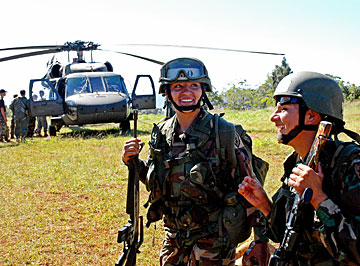HAWAII'S MILITARY

GREGG K. KAKESAKO / GKAKESAKO@STARBULLETIN.COM
A 25th Infantry Division soldier prepares to rappel out of a UH-60 Black Hawk helicopter at Schofield Barracks East Range in Wahiawa.
|
|
Training course goes on hiatus
Schofield's air assault school closes again as soldiers prepare to deploy for war
THE 25TH Infantry Division's last class of air assault candidates began with 115 soldiers. Eleven days later, only 90 completed the physically and mentally challenging Army course.
And it will be awhile before the nearly 25-year-old school will reopen again.
With more than 7,000 Schofield Barracks preparing for a year-long combat tour in Iraq, military leaders at 25th Infantry Division decided to close the school, located on the East Range off California Avenue in Wahiawa.
Lt. Col. Walter Piatt, assistant chief of staff in charge of operations, plans and training, said, "Currently, our No. 1 priority is getting our soldiers trained and ready to deploy, and in this case, it means returning these soldiers to their units so they can prepare as teams."
The school also closed in November 2003 as the 25th Division prepared for its previous deployment to Iraq and Afghanistan. The Schofield Barracks air assault school, one of two accredited by the Army, reopened in August after the soldiers returned.
First Sgt. Fidelito Ordonio, who heads the school's 17-member faculty, said soldiers seeking to qualify for the coveted air assault badge can try to get into the other accredited school at Fort Campbell. Ky. But he acknowledged that could be tough since priority is given to Fort Campbell soldiers.
"The other possibility is bringing instructors from Fort Campbell to Hawaii," said Ordonio, who has been with the Schofield Barracks school since returning from Iraq earlier this year. "We've run similar classes in Alaska and Washington."
After Friday's graduation ceremony, only six of the 17 staff instructors were retained. Ordonio said they will staff a 10-day course to assess whether a soldier will be able to complete the Army's premier special warfare school, the two-month Army Ranger school at Fort Benning, Ga.
Since the Schofield Barracks school was started in the 1980s, Army officials estimate it has trained more than 32,000 service members from all military branches and allied countries.
Soldiers undergo the demanding training for various reasons.
Chief Warrant Officer Maria McDonald, a personnel technician, wanted to challenge herself.
"I want to see if I can do it," said the 32-year-old single mother, who has been in the Army for 12 years.
First Lt. Matt Wagner, a former member of the Wisconsin Army National Guard before he voluntarily went on active duty, said he wants to take what he has learned back to his unit, the 58th Military Police Company.
Sgt. Berenice Zamora-Barrot, a supply specialist, cited the value of the training she received, which is important since her unit, the 3rd Brigade Combat team, will be going to Iraq next summer.
Zamora-Barrot, 22, is one of six women in the air assault's last class.
Several of the soldiers cited the school's "zero day" as being most intimidating part of the class.
Ordonio explained that during "zero day," prospective students are put through a series of tests, including completing an obstacle and confidence-building course.

GREGG K. KAKESAKO / GKAKESAKO@STARBULLETIN.COM
Sgt. Valerie Baldwin, left, and Chief Warrant Officer Maria McDonald share a light moment before boarding a UH-60 Black Hawk helicopter at the 25th Division's East Range. The two are members of the division's last Air Assault School.
|
|
"We do that to assess whether the soldier has both the physical and mental attitude to complete the course." said Ordonio.
"It was the physicality of zero day," Wagner said. "You never knew what they were going to throw at you. They always had something."
Besides learning how to rappel from a 45-foot tower and a UH-60 Black Hawk helicopter, the students were taught how to prepare, rig, and inspect numerous pieces of Army equipment.
There is one crucial physical test: a 12-mile road march with a 35-pound pack on their back under three hours.
"It's a unique road march," said Ordonio. "Most of the way is unpaved; there are several hills and three bridges to cross. In the end, it's something to see these soldiers push themselves to complete."
There were 115 students when the class began on Dec. 2. On Thursday, only 97 were left as they practiced rappelling from a Black Hawk hovering a hundred feet overhead.
Friday morning, 90 soldiers completed the 12-mile march under three hours and now are authorized to wear the air assault wings on their uniform.

